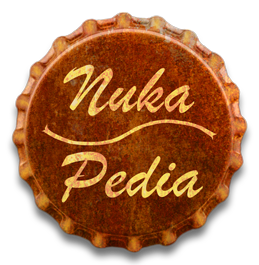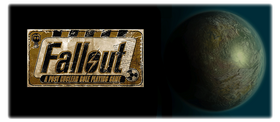The setting of Fallout exists in an alternate timeline that completely diverged from our own timeline after World War II. [Non-game 1] [Non-game 2] [Non-game 3] From this split all the way up until the Great War in 2077, a technologically advanced retrofuturistic atomic age representation of the 1950s dominated the culture and society of the fiction of Fallout.
In particular, the United States was dominated by the continuation of a corrupted American Dream and an overly suppressive form of American exceptionalism. The science-fiction anthology Worlds of Tomorrow, published during the Golden Age of Science Fiction in the 1950s, heavily influenced this representation.
Overview[]
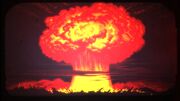
Great War
The divergence concept allowed the development team creative freedom to develop the game as they saw fit. The core idea was a dark game world, based on the horrors that 1950s science often predicted for a future apocalyptic world, balanced with humor.[Non-game 4] This has influenced all levels of development, first and foremost the art style and the technology of the setting.
Aesthetics[]
Aesthetically, it is a future inspired by what the people of the 1950s thought it would be: Road cruisers with an Art Deco aesthetic and fins, dominant Art Deco, Googie, and Raygun Gothic[Non-game 5] architecture (Brutalist, Usonian,[1] steel constructions, Lustron, Neoclassical, American colonial, Federal, and Victorian as well), reel-to-reel computers, big, bulky power armor (inspired by Wasteland and Starship Troopers), large and clunky robots, and so on and so forth. The idea was pitched by Leonard Boyarsky and eventually accepted by the team.[Non-game 6][Non-game 7]
However, the game's aesthetics have been inspired by a great variety of sources spanning most of the 20th century. These include movies Forbidden Planet (1956), La Jetée (1962), Star Wars (1977), Mad Max 2: The Road Warrior (1981), Blade Runner (1982), Brazil (1985), Batman (1989), Ghost in the Shell (1995), and The City of Lost Children (1995), which played on an almost continuous loop in the artists' office. Frank Miller's and Geoff Darrow's work on Hard Boiled and Big Guy and Rusty, the Boy Robot[Non-game 8][Non-game 9][Non-game 10] Urban and suburban U.S. of the 1940s and 1950s also inspired some of the artists, including vehicle design, signage, architecture, and art.[Non-game 11]
In one of the previews, Tim Cain even pointed out that while the general framework of retrofuturistic art was there, the "rule of cool" was in effect: Any time one of the design team came across a picture of a weapon or piece of armor from anywhere they liked (including Soldier of Fortune or Ladies' Home Journal) and they felt it was good enough to include, it was added. It reminded him of Mystery Science Theater and their approach to jokes: Not everyone would get it, but those who did would appreciate it.[Non-game 12]
Technology[]
As can be seen in the above quote, the technology of the setting were dictated by the technology and fiction of the Golden Age of Science Fiction, namely the 1950s. As such, Fallout included vacuum tube electronics, rather than the integrated circuits popularized in subsequent decades (although the transistor and use of integrated circuits would remain as a somewhat controversial part of the series design and aesthetic), ray gun energy weapons, giant mutants, the whole nine yards.[Non-game 13] The aforementioned 1956 movie Forbidden Planet was shown to artists as a summary of what the technology of Fallout should look: An honest 1950s vision of the future, with clunky robots, ray guns, and the general "feel." Some elements came from much later movies, as is the case with the T-51 power armor, inspired by the armor worn by thugs from The City of Lost Children (1995).[Non-game 10]
However, the setting isn't meant to accommodate every bit of junk science that comes to mind. Scott Campbell specifically introduced the Forced Evolutionary Virus to provide a more plausible explanation for the more stunning mutations found in the setting, without handwaving it as the "power of radiation," which would harm versimilitude.[Non-game 14]
Politics[]
While Fallout is based on the future visions of the 1950s, it is not the 1950s transposed to the future. One of the most noticeable changes is the replacement of the Soviet Union with China as the communist foil to the capitalist, democratic United States. As pictured in the above quote, Scott Campbell believed the post-collapse Russia could not be a convincing arch-enemy of the United States. However, considering the 1980s and 1990s concern about East Asian countries dominating the global economy, China was very plausible.[Non-game 15] The political situation did not parallel real world developments. The hardline policy towards China mimics the U.S. foreign policy of the 1950s and the 1980s, with Fallout 3 and Fallout 76 emphasizing the MacCarthyist and HUAC aspects of the setting, following the example of Van Buren.[2] The Soviet Union also existed as late as 2077, whereas in our world, it collapsed in 1991.[3][4]
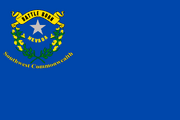
The Nevada state flag.
(Note the addition of "Southwest Commonwealth" in the left canton).
Domestic politics of the United States were an interesting modification of real-world tendencies. By 1969, the 50 states of the nation had been unified into 13 super-states, the commonwealths.[Non-game 16] The real reason behind this was because Leonard Boyarsky believed the design was cool and illustrated the changed America much better.[Non-game 17] This was not elaborated upon until much later, in Van Buren and after its failure, Fallout 3, Fallout: New Vegas, Fallout 4, and Fallout 76.
Society[]
The society of the Fallout setting is an interesting mix of contemporary and modern elements. The pre-War society was inspired by 1950s Americana, including widespread consumerism, fascination with technology, staple 1950s TV dinners remaining popular, fervent patriotism and anti-communism, though it lacks the many less appealing elements of the time. There was less evident institutionalized racism, widespread anti-feminism, or suppression of sexual minorities in pre-War America.[5] Gender stereotypes were still present, though they did not seem to constrict one's life to the same degree as in the 1950s.[6]
In general, the post-nuclear society is far more egalitarian than the source material would imply, reflecting modern sentiments and tendencies. Women fight alongside men, occupy positions of influence, and even serve in armies on equal terms. Racism is conspicuously absent in the games, replaced by hatred towards mutated humans.[7]
The culture of the Fallout universe is that as envisioned in the 1950s, in essence modern Americana. Although the subculture movements, like Hippie, Beatnik, and Punk were around, their movements just never materialized as mainstream.[8]
Flora and fauna[]
The distinctive creatures of Fallout were the result of exposure to radiation and biochemical agents released during, before, and after the Great War. New species of both flora and fauna being created almost overnight, the impact of these spices combined with the latent contaminants impacting where and when life could grown and heal.
The near spontaneous rise of many new species is most evident in larger, hardier and more dangerous mutations of animals and insects. Creatures such as radscorpions, giant ants, and brahmin descended from emperor scorpions, household ants and cows, respectively.
Among the humans subspecies and mutants would emerge. One such subspecies is the slags, a group of humans who adapted to life underground and have pale skin, enlarged pupils, and a sensitivity to light. Another subspecies are the swampfolk, inbred residents of Point Lookout who have slowly devolved over the decades. They have sinewy, pockmarked bodies, and ooze with pus. The swampfolk are stupid, violent, and strong.
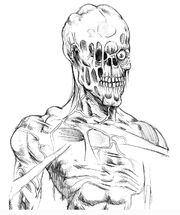
A ghoul
Ghouls are humans or animals who were subjected to fatal levels of radioactive poisoning, but did not die. Due to unknown factors, rather than suffer organ failure, their bodies mutated and adapted to radiation, resulting in immunity and an extended lifespan. The drawback is that the adaptation also caused widespread necrosis of the skin, lesions, and rot, resulting in a horrifying appearance that has been likened to that of undead creatures from pre-War horror films. This is also the primary cause of ghoul discrimination in the wasteland, with its mildest being racial slurs like "zombie." Another ghoul variant includes the glowing ones, who, as their name suggests, literally glow. They can be both normal and feral. Feral ghouls, unlike normal ghouls, have lost their ability to reason and have become aggressive. This has caused much discrimination by human wastelanders toward other ghouls who have retained their mental faculties.
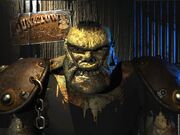
Harry the super mutant
The origins of the super mutants lies in the Forced Evolutionary Virus, the development of West Tek's Pan-Immunity Virion Project. The goal was simply to make the human immune system strong enough to resist any pathogen, natural or engineered. Some of the side effects, discovered during testing, were increased size and strength. The catalyst for the project was the New Plague, which ravaged the planet in the 2050s. In development since 2073, by 2075 the project moved from an effort to defend against a Chinese biological attack, to creating larger, stronger, and smarter creatures. The federal government became increasingly more interested in the project.
In early 2075, West Tek and the government offered the West Virginian town of Huntersville a rural development grant. Seeking an end to their economic floundering the town accepted, with no idea that they were to become lab rats. The flow of commerce suddenly halted in February 2076, after several people fell ill with a strange disease. The town suddenly became quiet as the commercial traffic from West Tek stopped and more and more people started to become sick. As the situation steadily deteriorated, West Tek physicians convinced the people of Huntersville that it was just a rare strain of flu. It was not. By August, armed hazmat teams guarded the town, and by November the 12th Mountain Division was deployed to the town and ordered to enforce the quarantine. This was not enough, as the 12th Division was simply unaware of the threat the now-mutants posed and were overwhelmed, creating a local populace of mutants that would harass the region for decades to come.
Another source of FEV was Vault 87. Constructed as a part of Project Safehouse, starting May 2066 and finishing in December 2071, this Vault's experiment was the Evolutionary Experimentation Program, an aerosolized variant of the FEV. This too would create a local population that would escape the Vault and become a dominant, if fragmented, force in the region for centuries to come. Two centuries later, this variation of FEV made its way into the hands of Dr. Weston Lesko, who inadvertently created fire ants in an attempt to shrink the giant ants back to their pre-War size. These mutants would spread across the continent within a few years.
On January 6, 2076, the military secured West Tek research sites in the name of national security, effectively nationalizing the company. The next day the all Californian FEV research was moved to the newly-constructed Mariposa Military Base from the West Tek facility to commence testing of the virus on human subjects, and eventual full scale production.

The Master
Following the Great War, Mariposa was abandoned, the surviving guardsmen having left to form the Brotherhood of Steel. After laying dormant for 30 years, the base was rediscovered a team led by Harold, a successful merchant of the Hub. Seeking an answer to where the increased mutant attacks on their caravans were coming from. Among the team was Richard Moreau, an exile from Vault 8. After their loss to the automated security, only Harold and Richard would emerge from the facility. Neither would be unharmed, as both were exposed to contaminants. Each would continue to mutate, with only Harold retaining his sanity. Eventually, Richard Moreau, now calling itself "The Master," realized that the FEV could be used to create a mutant capable of thriving in the post-nuclear world, he attempted to raise an army to conquer the world, but was defeated by the Vault Dweller.
Despite the destruction of Mariposa base, however, a sample of its FEV was claimed by the Enclave. Using slave labor kidnapped from nearby Redding (among other places), the Enclave excavated Mariposa. Those slaves inadvertently exposed to the FEV mutated into a new batch of super mutants.
Locations[]
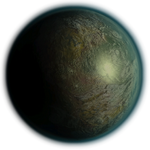
A view of the Earth, post-war, showing the Americas and the Atlantic ocean.
The Fallout series takes place mostly in the former United States of America. Apart from the Fallout 3 add-on Mothership Zeta which takes place in orbit above the planet. From there the games separate their world spaces by regions.
New California[]
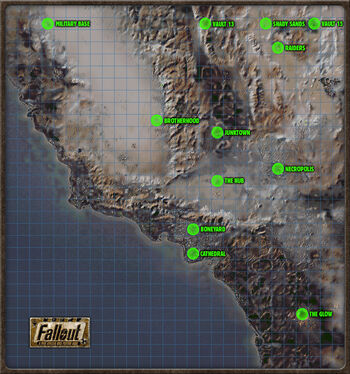
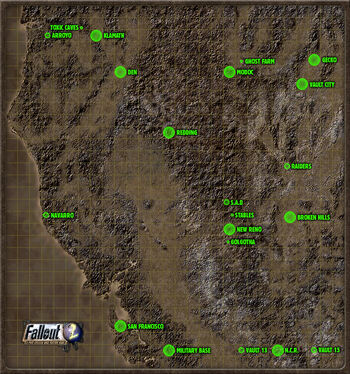
"New" California stretches from southern California in the south to southern Oregon in the north, to western Nevada to the east. It is a largely inhospitable region, which is why most people have chosen to seek refuge in the ruins of the old cities, where they have found relative safety in numbers. However, as resources grew more and more scarce, people came to consolidate into groups of their own kind, and as a result locations are far more homogeneous than one might expect from a world ravaged by mutation. Although once fragmented, the region has coalesced into the New California Republic by 2281.
Mojave Wasteland[]
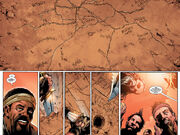
A crudely drawn map of the Mojave Wasteland.
The area of the Mojave Desert, the second largest desert in North America, eventually became known as the "Mojave Wasteland." It occupies a significant portion of southern (and a part of central) California, southern Nevada, southwestern Utah and northwestern Arizona, and serves as the primary setting of Fallout: New Vegas. While the majority of Fallout: New Vegas takes place here, several of its add-ons take place elsewhere. Honest Hearts takes place in Zion Canyon, Utah, while Dead Money takes place in the ruins of the Sierra Madre Casino & Resort. Old World Blues takes place in what was the Big Mountain Research and Development Center, and Lonesome Road takes place in The Divide.
Capital Wasteland[]
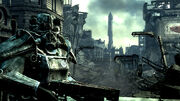
Washington D.C., as seen in a Fallout 3 promo image with a member of the Brotherhood of Steel.
The Capital Wasteland is a term which refers to a loosely defined geographic region, spanning areas of Virginia, Maryland, and the District of Columbia surrounding the Potomac River from (roughly) Harpers Ferry to the Potomac tidal basin. While the majority of Fallout 3 takes place here, several of its add-ons take place elsewhere. Point Lookout takes place in and mostly around Point Lookout, Maryland, while The Pitt takes place in Pittsburgh, Pennsylvania. The aforementioned Mothership Zeta takes place in orbit, the only instance of non-planetary Fallout in the series, and Broken Steel takes place mostly in Washington, D.C., although there is a detour to a satellite relay station to the south in Virginia. Finally, Operation: Anchorage takes place within virtual reality, another first for the series, the Anchorage Reclamation simulation.
The Commonwealth[]
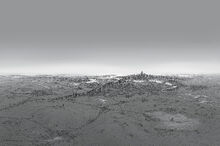
Aerial view of the Commonwealth from The Art of Fallout 4
The Commonwealth largely encompasses the former Commonwealth of Massachusetts. The in-game map takes place in Middlesex, Essex, Suffolk, and Norfolk Counties. Among other locales, the Commonwealth includes the former state capital of the City of Boston. While the majority of Fallout 4 takes place in this area, its add-on Nuka-World takes place in and around the Nuka-World theme park and home of the Nuka-Cola Corporation somewhere west of the game map, and the add-on Far Harbor takes place on and around Mount Desert Island in Maine.
Appalachia[]
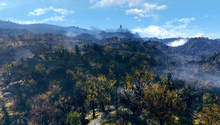
The in-game map of Fallout 76, titled "Appalachia," encompasses most of the State of West Virginia. The name comes from the cultural region of Appalachia, and the Appalachian Mountains which stretches from the Southern Tier of New York State to northern Alabama and Georgia. With the addition of the "expeditions" to the game, the players can take trips to The Pitt, Pittsburg, Pennsylvania and Atlantic City, New Jersey.
Factions[]
Throughout the post-War world, societies would emerge and take forms mirroring their pre-War predecessors.
Republics and nation-states[]
From humble origins as Vault dwellers and their settlement of Shady Sands, the New California Republic is a great example of a successful post-War nation-state. Composing of five states and more territories, it encompasses almost the entirety of California, and its borders extend into Oregon and Baja California. Another example of a nation-state is the Shi. Descended from survivors of the Chinese submarine Shih-huang-ti, they have coalesced as an imperial bureaucracy. Although they claim to be lead by their emperor, they are led actually by their head advisor. Their territory consists of San Francisco's Chinatown and surrounding environs.
One of the most reclusive post-nuclear governments is the Enclave, descendants of the U.S. federal government that considered themselves to be the continuation the United States of America. Their prolonged isolation from the world around them inhibited them from realizing that the Sino-American War was over. This, combined with a civilian culture of wartime propaganda merged with an extreme paranoia against mutations, culminated in an attempt to commit global genocide. With that plan stopped, by the destruction of their main base, Control Station ENCLAVE, the survivors eventually trekked east to the Capital Wasteland to rebuild at the Raven Rock complex. From there, their new leadership would attempt a similar plan, and be similarly defeated.
The smallest known "republic" is nestled in a far corner of the Capital Wasteland. The Republic of Dave, a hamlet that considers itself a nation, has gone through many names and forms of government over the generations. Originally formed from very patriotic survivalists, over the past two centuries this group kept changing its structure based on its leaders' wishes, from kingdom to republic and back again.
Empires and despotism[]
Other than nations or republics, despots and empires have been found across the wastes. Prior to the rise of the NCR, the Unity was among the largest and most well-organized factions populating California. Formed and developed as a part of the Master's insane plan to conquer and control the world, it was comprised of the Master's mutant and human followers. Its goal was to create a single united mutant race capable of surviving in the harsh post-nuclear world and being united by a single ruler. To spread this literal transhumanist movement they formed the Children of the Cathedral as a front organization. They would establish churches and hospitals in various settlements across the wastes in a move to gather information and lives before Unity would march in and capture them. Following the destruction of Mariposa Military Base and the Master himself by the Vault Dweller in 2162, the Unity collapsed in on itself without their leader to guide it. Surviving mutants fled east, while the Children of the Cathedral ceased to exist with the loss of their literal god and most holy sites. Its survivors dispersed and faded away.
An example of an empire is Caesar's Legion: an imperialistic, reactionary, and totalitarian dictatorship based on large-scale slavery and tribal dominance. It was founded in 2247 by Edward Sallow, who then renamed himself Caesar, and Joshua Graham, also known as the "Malpais Legate." The Legion uses trappings of the ancient Roman Empire as part of a unifying identity imposed on its tribes but does not recreate any cultural, social, or political institutions of ancient Rome. The Legion itself is simply a slave army built on ruthlessly utilitarian principles, supported by several tributary populations. Its territory is the former states of Arizona and New Mexico, with footholds in Utah and Colorado.
An example of a city-state with despotic rule is the Pitt (an area within pre-War Pittsburgh), controlled by Ishmael Ashur's raiders, who coalesced from the remains of scavengers and lesser raiders into a powerful regional slave state. Another is the slavers of Paradise Falls, who for decades have operated unimpeded. Still another is the isolated confederation of the Institute: founded by survivors of the Commonwealth Institute of Technology (an analogue to the real-world Massachusetts Institute of Technology), these people would dedicate themselves to science and technology. Eventually, they would perfect robotics with their androids and grow in power to threaten entire regions.
City-states and other independent settlements[]
By far the most numerous factions are independent settlements, whose cultures and development are dependent on those who would found and populate them. An example is the Free Economic Zone of New Vegas, founded and led by Robert House, the FEZ-NV is a liberal autocracy run as corporatocracy. Another example is Rivet City. Founded by the Naval Research Institute, it would grow to be a regional hub of science, and commerce. Similar to Rivet City is Diamond City, founded by people seeking shelter from the elements, its reputation bordering on admiration dissuaded nefarious groups from attacking. It would develop its own minor economy, and become a hub of civilization in its region.
Unlike the aforementioned settlements, Vault City was founded established by the inhabitants of Vault 8 after they emerged following the Great War. Best known for their medical technology, its culture is that of a Vault-Tec Vault-turned state. In stark contrast is New Reno, a wild town where the law is that of the criminal syndicates, where various mafia families vie for power in a city dedicated to vice.
Not all settlements manage to survive. Necropolis, the remains of the now-ghoulified population of Bakersfield, California, would be conquered by the Unity, and the few survivors forced to migrate to other settlements, like Gecko. Another example is Broken Hills, whose entire existence lies in its active uranium mines and is abandoned when they run dry. Its founder, Marcus, would eventually leave and found another settlement, Jacobstown. This small mountain village's purpose is to be a refuge for the "broken-minded" of his kind.
Other examples of organizations that wouldn't survive are the Responders and the Free States. The former formed as a collation of various pre-War emergency services in the Appalachian region, first operating alongside the Charleston Emergency Government until it and Charleston itself were destroyed during a raider attack known as the Christmas Flood. The Free States formed as an anarchist, secessionist militia movement primarily consisting of Appalachian survivalists. Both would fall to the Scorched Plague, with the former being resurrected by others wishing to live their lives through their example.
Tribes, raiders, and cults[]
In contrast to the more organized and settled groups of the wasteland, tribes have emerged as stateless societies. They range from stereotypical primitive, uncouth, and unsophisticated bands to groups with a level of sophistication resembling that of developed states. Despite the absence of formal government, they tend to have a distinct cultural identity, and self-sufficiency. Some examples include the tribal villagers of Arroyo, the Boomers of Nellis Air Force Base, or the Treeminders of Oasis.
Lacking most if not all of the above are raiders. This is a blanket term for the dangerous hostile wastelanders who pillage, plunder, murder, etc, anyone unfortunate enough to cross their path. Raiders occasionally organize into loose confederations of gangs. They are known to prey upon lone travelers and small towns, leaving larger groups and more populous settlements alone, though in great enough numbers they can pose a major threat to the security of a region.
Unlike all the examples above is the Brotherhood of Steel, a techno-religious military order. Operating across the ruins of post-War North America, its dedicated to controlling and regulating technology in the wasteland. Though small, the Brotherhood has been an influential group in the history of the wasteland. First as a survivalist group with limited firearm manufacturing, next a major research and development house, then as the enemy of the New California Republic. Having suffered defeats in the west, the Brotherhood would be strengthened on the eastern reaches of the continent, under Elder Arthur Maxson.
The religions that survived the war and subsequent loss of information and continuity that nuclear Armageddon brought had varying degrees of degradation. Some would survive completely intact while pockets would become amalgamated with fabrications. With the apocalypse new cults would also emerge, from the epitomal cargo cult to totally fabricated cults built to enforce rule by despots. For examples of surviving pre-War faiths, Christianity and Dharma, while post-War cults include the Children of Atom and the Children of the Cathedral.
See also[]
Developer quotes[]
All of those things were kind of crummy for a while, but if we hadn't gone through the stage of "Yeah... this is... okay, I guess," we would never have reached the subsequent stages. Coil/rail gun technology used to be completely impractical. Now it's reached the stage where maybe/sorta we could mount an enormous one on a destroyer and blast through a bunker with a huge slug from miles away. We're probably not going to have Eraser- or Fallout-style Gauss rifles for a while, but we see the potential.
In the Fallout universe, I think that the military appeal of weaponry that uses a small number of more-or-less universal ammunition types would be great. Today, we have NATO standards so that allies armies can share ammunition. But what if you could use the same ammunition type for powering a sniper rifle that you'd use for a devastating close-range weapon (e.g. a Microfusion Cell powering a Laser Rifle or a Plasma Rifle)? For a military force in the field, the flexibility of that would be immense.
Anyway, I considered the EWs in F:NV to have reached the point where they were starting to replace conventional weapons, but had not yet completely eclipsed them -- sort of like the early days of firearms, when they were still being used concurrently with bows.”— J.E. Sawyer on energy weapons in the Fallout universeReferences[]
- ↑ Although self-evident; Usonianhome01Int Template and Usonianhome02Int Template.
- ↑ Fallout 3 and Fallout 76
- ↑ Natalia Dubrovhsky's profile.
- ↑ The Switchboard terminal entries; research terminal, > 2067 Jun 19
- ↑ Fallout, Fallout 2, Fallout 3, Fallout New Vegas, Fallout 4, and Fallout 76 do not indicate this was the case.
- ↑ Fallout 3 loading screen.
- ↑ Fallout series overall.
- ↑ The words exist in the parlance of the fiction and hold the same meaning, indicating these subcultures manifested in virtually identical ways.
Non-game
- ↑ The Art of Fallout 4, p. 22: "BOSTON
Much of modern-day Boston's skyline consists of buildings that were constructed well after Fallout's timeline diverged from our own. The taller structures that make the city recognizable are too contemporary in their designs. That gave us a blank slate to work with in terms of designing our version of a city of tomorrow. The older historical aspects of the city were retained for authenticity, but we wanted to layer them with some futuristic architecture, as this is a type of environment that hasn't been explored yet in the Fallout universe. As you can see in these early concepts, we explored some pretty far-out ideas for just how built up and evolved our version of Boston would be. We ended up with a more balanced approach—something that felt different but was still a grounded and relatable metropolis." - ↑ Fallout Bible 6: "3. What was U.S./world history like before the timeline included in previous Fallout updates?"
"No one has asked this yet, but I thought I would cut this question off at the pass. Fallout takes place on a future earth, in an alternate timeline. I will not be including any information on how and when it diverged - it will remain one of the mysteries of the setting. Just let it be known that it diverged after WW2, and leave it at that." - ↑ Bethesda Softworks v Behaviour Interactive: "The FALLOUT franchise of video games draws gamers into alternate history, diverging from existing reality shortly following WWII. The various FALLOUT video games largely take place in the years following the destruction of the earth as people begin to emerge from their underground vaults into the nuclear wasteland."
- ↑ Tim Cain
- ↑ Fallout Retrospective Interview
- ↑ Leonard Boyarsky Developer Profile: "As Art Director, I was responsible for the look and mood of the game (as far as visuals were concerned). I came up with the idea of the "future of the fifties" setting, and had to convince everyone that that was the way to go. I also came up with the idea/design for the "Vault Boy" and the "cards" (as I called them) showing him doing all the different things in humorous ways. By the way, he's not the Pip Boy, the Pip Boy is the little guy on your Pip Boy interface. The Vault Boy was supposed to evoke the feel of Monopoly cards, and the Pip Boy was based on the Bob's Big Boy mascot."
- ↑ Fallout Bible 8: "Hey, Rob - the basic theme of the Fallout games is that the world of 2077 had a retro-50s feel when the nukes dropped - sort of a "what people in the 50s imagined the future (and post-holocaust future) would be like." This theme translates into the "look" and the actual physics of the world (Torg-style, if you've ever played Torg) - so anyway, you get giant radioactive monsters, pulp science with lasers, blasters, vacuum tubes, big expensive cars with fins, Art Deco architecture, robots with brains in domes atop their heads, lots of tape reel computer machines, the whole "atomic horror" feel, and it explains the artistic style of the interface."
- ↑ Leonard Boyarsky Developer Profile: "I was really influenced by "The Road Warrior", "The City of Lost Children", and "Brazil" in terms of movies, and the comic book series "Hard Boiled"."
- ↑ Tim Cain: "I don't think I can answer this, since so many people has a hand in the design and scripting, and it seems everyone put in their own little in-joke or reference. I mean, I'm surprised by some of the things in the game!
But some of the movies the inspired us were Road Warrior, Brazil, City of Lost Children, Blade Runner, Batman, Ghost in the Shell, On the Beach and of course, Star Wars. A lot of adventure ideas were variations on things I've seen in MUD's about 7 years ago at the peak of my playing.
As far as books, oddly enough the book "Lord of Light" by Zelazny was an inspiration. Not so much for material but for the main character Sam. He was driven by a morality in that he was actually trying to help people from being oppressed, and I used to think "What would Sam do?" when testing an adventure that required the player to want to help a town.
Of course, others on the team like to think "What would Brian Boytano do..." :)" - ↑ 10.0 10.1 Tim Cain GDC talk
- ↑ Tony Postma: "Urban and Sub-urban America of the 40'-50's....the cars, the signage, the art, the architecture...all of it. I already had a few books with photos and documentation of the period. Also the comic books "Big Guy and Rusty, the Boy Robot" and "Mister X" by Dean Motter help with the machinery and the mood."
- ↑ CD Mag Fallout preview: "Any time one of the design team came across a picture of a weapon or piece of armor from anywhere (such as Soldier of Fortune or Ladies’ Home Journal) and it was “cool enough” to include, it was fair game. Entertaining gems have been imported from just about everywhere, hence almost everyone will find something about which to reminisce. Says Tim Cain, producer/lead programmer, “It reminds me of Mystery Science Theater. They always say, ‘People aren’t going to get all of our jokes, but the people who will get them will really appreciate them…’."
- ↑ Tim Cain: "Hey, we're not that old! I'll have to check my picture on the web page.
Seriously, the artists just thought that 50's tech looked cool. So they set out to make a future science that looked like what the Golden Era of science fiction thought that future science would look like (if you can follow that sentence). Vacuum tubes, ray guns, mutants, the whole works. And I think they succeeded quite well.
We didn't start out this way. Over the 3.5 years to make this game, things changed a lot (take a look in /program/goodies, for example). One day I may write the story of the making of this game. Not in my wildest dreams did I imagine what the process would be like. The high points were very high, and the low points were very, very low. If I had to do it again..." - ↑ The Origins of Fallout: "Why did we bother with the Forced-Evolutionary Virus and not just say radiation caused the mutations? Unfortunately, science tells us high levels of radiation just kill things. Lower levels can cause mutations, but more than 99% aren't advantageous, and often lead to early death. I wanted to explain how something like a Radscorpion could have evolved and proliferated in the course of 60 years - and to me, "it's the power of radiation!" was way-too-obvious junk science.
Because I wanted a plausible game back-story, I wanted explanations that were a little more scientifically plausible (or at least more believable than the plot to THEM!) I also wanted this virus to be part of the main villain's master plan - making a race of super mutants from human stock by subjecting them to a vat of this refined viral agent." - ↑ Scott Campbell, Origins of Fallout, No Mutants Allowed: "The nuclear Armageddon in the back-story was between the US and China. After shipping several people asked me why China and not the old standby, the Soviet Union. I made the choice when I remembered experiences with Oleg, a Moscow developer I worked with months before when I was assistant-producing a typing game. Once, in the middle of a phone conversation, I heard some muffled bangs, and the phone went quiet. When I asked him what the noise was, he replied, 'Oh, it was just the Russian mob firing their guns in the street.' I thought he was joking - he wasn't. After that, I had a really hard time believing that the once mighty USSR would be in a position to threaten the world any time soon. So I turned to the next major communist country that typifies 'the East': China."
- ↑ Fallout 4 Vault Dweller's Survival Guide Collector's Edition pp.471-472: "[14.01] Massachusetts State House
The “new” state house was completed in 1798 to house the government of Massachusetts State. The land selected was originally John Hancock’s cow pastures. The first dome was constructed of wooden shingles and covered in copper smelted by Paul Revere. The state government used this building continuously until the formation of the Thirteen Commonwealths in 1969.
This is part of the Freedom Trail. The number “4” is daubed on the circular ground plaque pointing at the letter “L.” Outside, one corner of the structure has collapsed, allowing lock-fiddlers the chance to open a wall safe (Novice)."
(Fallout 4 Vault Dweller's Survival Guide Map) - ↑ Fallout Bible 8: "Leon [Leonard Boyarsky] said he used that flag because it looked cool and he didn't want to use a standard American flag with 50 stars. Eventually he planned to make up something about 13 super-states or something, but he never did."
- ↑ Tim Cain
